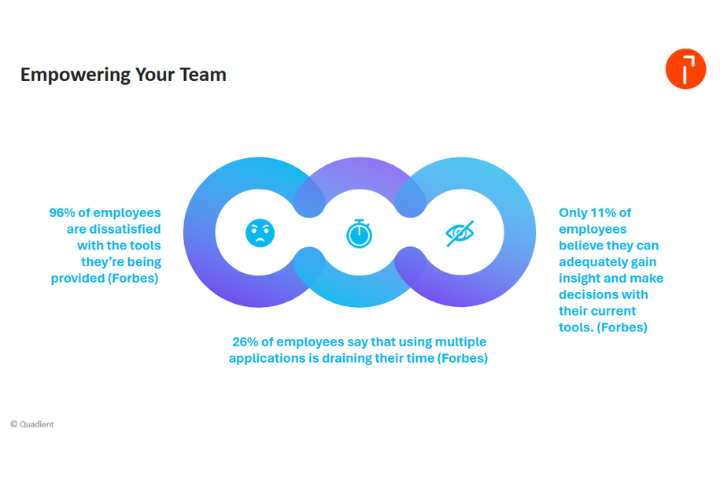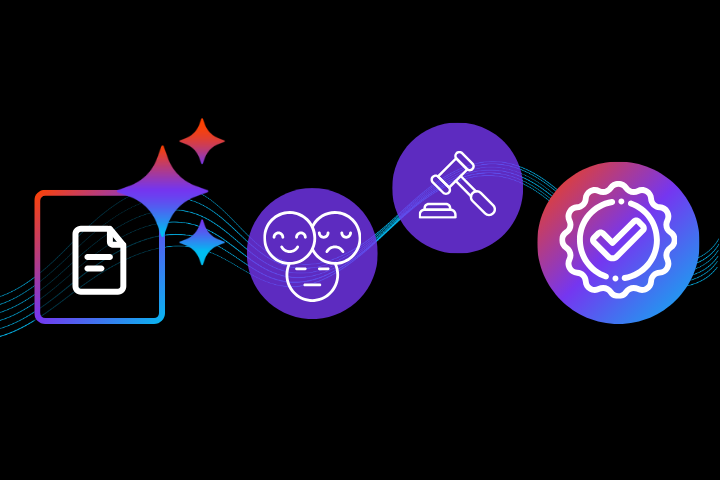Solving Your Top AP Challenges in 2022
Download

Recent surveys showed that 70% of AP professionals identified manual and inefficient processes as their top concern1. On top of that, 99% of CFOs are
unable to accurately forecast their spending beyond 30 days2, and 82% of AP departments experience some kind of fraud3. One company told Quadient AP they typically touch one invoice five times before it is actually matched to a check stub and then filed.
It is clear that a change in digital transformation in AP is more urgent than ever. But how do you make sure your AP processes are improved the right way, the first time? Digital transformation can often go wrong. One reason is that organisations often opt for makeshift solutions instead of looking at the whole picture.
For example, some companies might store payments information on a spreadsheet, and chase approvals through email, creating a complicated trail. They might use data entry tools, spreadsheets and document management systems for specific tasks. Or, they might choose a standalone solution automates only one part of the workflow from purchase to payment. The result is that only one part of the problem is fixed, and the digital transformation project ultimately fails.
Let’s take a look at each part of the AP workflow, from invoices, payments, purchase orders to expenses, the challenges they entail, and how to fix them.
Top Challenges in Accounts Payable
71% of AP professionals say manual processes are their top challenge1
99% of CFOs can’t accurately forecast their spend past 30 days2
82% of AP departments experience some form of expense abuse or fraud*
Purchase Orders
Manually processing a purchase order can cost as high as $89.73, according to a 2018 Paystream Advisors study.4 That’s due to fixed costs such as salary, along with variable costs including postage, office supplies and hourly wages.
Other issues include cases where there is an informal requisition process – for example, when employees create their own shortcuts – and lack of visibility into open purchase orders. When invoices are left uncategorised, this can delay the month-end.
Top Challenges
Informal requisition process (or no requisition process)
Lack of visibility into open purchase orders
Concerns over PO process delaying purchases
Uncategorised invoices delaying month-end
Unapproved purchases
Before automation
One of Quadient AP’ customers, pharmaceutical company Brickell Biotech, was using multiple document management systems for their POs. Their Chief of Accounting Jose said:
“Purchase orders were done manually – we would create a PDF of the purchase order and use Dropbox to keep track of invoices and payments against those purchase orders. It became really convoluted.”
How you can save 60% of PO costs
Companies that automate the PO process have saved up to 60%.5 They can save time with features such as invoice matching, and can also access the information they need quickly in the cloud. There is no need for a long paper trail and filing cabinets.
Accurate budgeting and forecasting driven by data is easier to achieve with automation. It helps finance teams analyse spend before it happens, rather than after the fact.
After automation
After moving their PO process into Quadient AP, Brickell Biotech’s Chief of Accounting Jose said: “The biggest advantage is having it all in one place and being able to generate reports. We can clearly see if a purchase order has been approved. It removes the risk of committing to something that we shouldn’t have.”
Invoices
If you have one AP clerk processing invoices full-time at $20 per hour, or around $3,440 per month, that means that 300-400 invoices would cost your business about $9-$12 per invoice.
Manually processing invoices means they are more likely to get lost, and there is a lack of accountability in the whole process. You are more likely to experience errors and slow approval times.
1 AP Clerk (at USD $20 per hour) = $3,440 /month in salary ÷ Processing 300-400 invoices/month = $9 - 12 per invoice
Top Challenges
Data entry time
Lack of accountability and slow approval processing
Lost invoices
Information silos
Before automation
Another Quadient AP’ customer is Kelly, a VP of Finance at a non-profit, which previously used SharePoint to process invoices. She said: “Managers and directors would decline invoices for something really minor. The process to re-submit the invoice was cumbersome. They would have to change the file name because SharePoint would only accept the same file one time, or it would produce an error.”
Cutting invoice processing costs
Automation can reduce the cost to $2.36 per invoice.1 Not only that, but it reduces the data entry time by 83%,1 and eliminates the need for an approval follow-up because anyone in your organisation who needs to approve invoices can do so through their browser or mobile app. They can leave notes for clarification on the invoice before approval.
This can help to reduce fraud by increasing controls, and reduce errors which can happen such as keying errors or duplicate invoices.
If your AP automation solution supports unlimited users, you can put an end to information silos since every approver has access to the system. You can also customise controls based on factors like location, invoice amount, department and more.
After automation
Back to Kelly, who was much happier after automating with Quadient AP.
“Our IT department was going to give a couple of months to transition to Quadient AP but our accounting team didn’t want two different systems. We had them cut off access to the old system immediately and we have never looked back.”
Expenses
The number one complaint about expenses is that they take too long. In a 2018 survey of 500 AP professionals, 47% said their top complaint was that expense submissions are time-consuming. In the same survey, 38% of employees said it took too long to get reimbursed.6
Meanwhile, 18% said they thought co-workers submit personal, non-work related expenses.6
Many said the books were inaccurate due to late information, and some said it was difficult to enforce expense policies.
Top Challenges
Inaccurate books due to late information
Risk of waste & abuse
Employee complaints about reimbursement times
Difficulty enforcing policies
Before automation
After using paper-based expenses, Robert, Director of Finance at Athabasca Catering said: “Our people working at the sites don’t have the luxury of working from home. Submitting expense claims became very challenging. So when we found this expense module, we just said, aha, there’s a way to solve that problem."
Streamline expense reporting, processing and reimbursing
Automation can dramatically speed up the expense management process – and that’s not the only benefit. A 2018 Paystream Advisors survey found that 66% of AP professionals who had automated their expenses enjoyed improved spend visibility.7 What’s more, 53% said their processing costs had been reduced, and 59% said it was easier now to enforce travel expenses policies.7 With automation, you can reimburse employees electronically, making them much less likely to complain about the time it takes.
The system eliminates double data entry, and employees can submit receipts through a mobile app, simply taking a photo of the report.
By choosing an AP automation tool that includes expenses, your AP team can manage all of the AP workflows in one place, without having to manage separate systems.
After automation
In a survey of 300 respondents with an expense management system:
66% noticed improved spend visibility 7
53% identified reduced processing costs 7
59% cited improved ability to enforce travel policies 7
"Reconciling expenses now takes 30 seconds "- Robert, Director of Finance, Athabasca Catering
SOLVING YOUR TOP AP CHALLENGES IN 20228
Payments
One of the big issues companies have with payments is the risk of fraud, which has become even more prevalent since the pandemic. There was an increase of 112% in fraud between the first and second quarter of 20208, and accounts payable is the most targeted department.
Manual data entry and inefficient processes are also a top pain point for 79% of AP professionals. When teams started working remotely in 2020, 46% of businesses were not in a position to make remote payments. They also struggle with high payment costs and said relationships with vendors were often damaged because of late payments.9
Companies try to solve this by tracking payments by email and storing data on spreadsheets – but this often fails. After automation, 37% of AP teams reported a reduced level of risk – from fraud, audits and compliance.9 They also made savings from supplier discount capture and cash rebates from using virtual credit cards. Payments providers often assume liability in case of fraud, which banks do not. Those who outsourced vendor data management also saved time on updating information about suppliers, while two-way sync systems can automate reconciliation, freeing up time and reducing errors such as duplicate payments.
“We wanted the ease of having AP systems in one place. Previously, a lot of our payments were by checks which were stored in physical spaces and Dropbox. Now, the physical storage is gone and we don’t use Dropbox anymore. We can easily identify duplicates online in the system.” - Jose, Chief of Accounting, Brickell Biotech
Getting a 360º view
Some companies miss out on a 360º view of their payables because they have a disconnected workflow. Software which puts all four AP processes in one place gives full visibility and is easy for everyone to use.
Quadient AP allows you to manage POs, invoices, expenses and payments electronically, in one easy-to-use system. Enable automatic routing and simplify approvals through the mobile app, get a better handle on forecasting with a complete view of your spend, and make timely payments.
*Download whitepaper for more information










